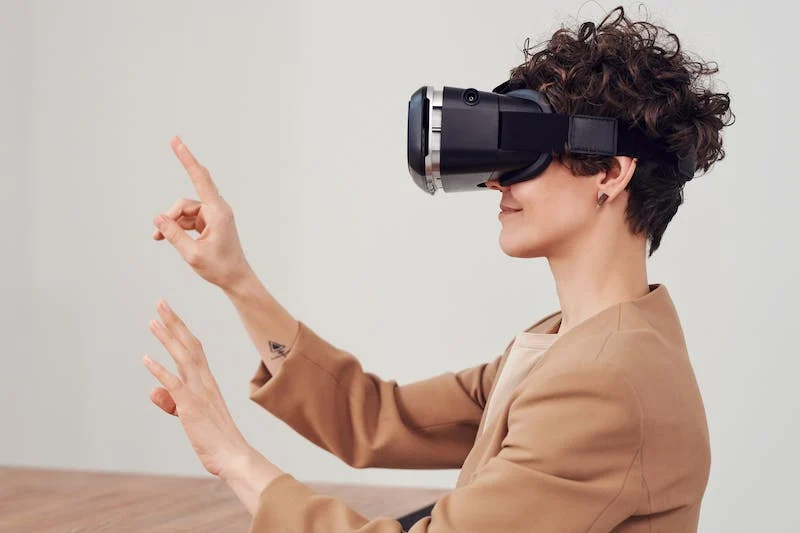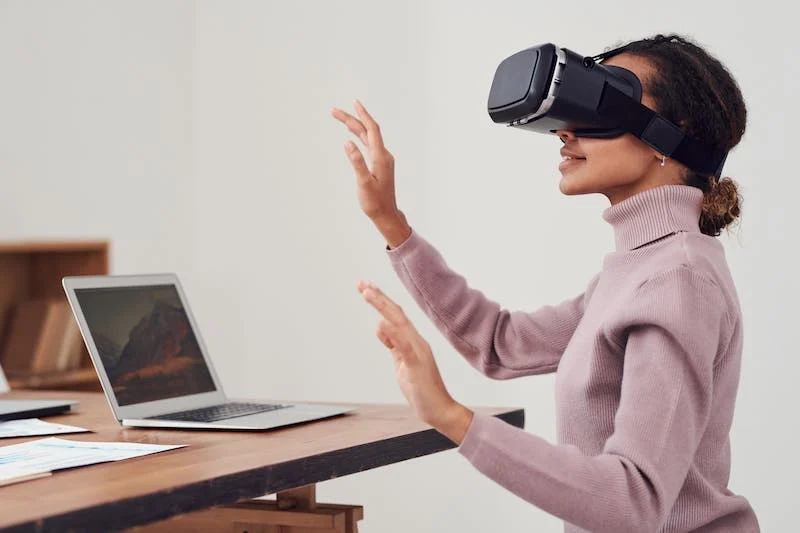Virtual Reality is a technology that allows you to experience a computer-generated environment, which can be as realistic as the real world or as fantastical as you want it to be. VR has been around for decades, but it’s only recently that we’ve seen VR headsets like the Oculus Rift and HTC Vive become widely available.
VR works by fooling your senses into believing that what you’re seeing in front of you is real–and because of this illusion, it has applications across many industries, including gaming and entertainment; education; design; medicine; architecture, and the list goes on!
The benefits of Virtual Reality (VR)

Virtual Reality is an immersive technology that can be used for education, entertainment, and training purposes. It offers a number of benefits over traditional methods of learning, including:
- Immersive Experiences – Virtual reality allows users to experience places, things, and events in a way that’s more realistic than ever before. This can make it easier for students or employees to learn about new environments or situations without having to actually visit them in person.
- Improved Interactions – A virtual environment allows people to interact with others through avatars instead of physically being together in real life (or even remotely). This means you don’t have to travel across town so that you can talk face-to-face!
Types of Virtual Reality technology
There are three main types of virtual reality technology:
- Head-mounted displays (HMD)
- Gesture-tracking devices
- Augmented Reality
Applications of Virtual Reality
Virtual reality is a technology that allows you to experience an artificial environment, which can be either virtual or real. Virtual reality has been used in gaming and entertainment, but it also has many other applications.
In healthcare, virtual reality can be used to provide patients with realistic training for procedures such as surgery or dentistry. It can also be used for rehabilitation after injuries or illness by helping them practice everyday tasks in their own home environment before returning back out into the world again.
Virtual reality is being used in education at all levels from primary school through university level courses where students are able to learn more effectively through immersive experiences rather than just reading about something on paper or watching videos online
The future of Virtual Reality
Virtual reality is the future of entertainment and technology, but what does that mean for us?
The first thing to understand is that virtual reality has been around for decades. The earliest versions were large and cumbersome–they required users to wear helmets or other headgear that covered their eyes and ears while immersed in a digital world.
But as technology has improved, so has our ability to create more immersive experiences. Now you can find VR headsets that fit snugly on your face like goggles or glasses; these allow you to see into another world without blocking out your surroundings completely (as would happen with an old-fashioned helmet).
Virtual Reality in popular culture
Virtual reality is everywhere. You can see it in movies, music, and television shows. You can hear it in songs and books. And you can read about it in magazines and newspapers.
Virtual reality is becoming more popular every day because of its ability to make people feel like they are actually part of something instead of just watching or reading about it from afar.
How to get started with Virtual Reality
To get started with virtual reality, you’ll need a few things. First and foremost is the hardware: a headset that fits your needs and budget. There are several options available for purchase, including Google Cardboard (which can be made at home), Samsung Gear VR, and the Oculus Rift.
Next up is software–the apps that let you explore the virtual world from within your headset. You can download these on your phone or tablet before putting on the headset; once inside, they’ll guide you through games or other immersive experiences by using head movements to direct where to look next.
Finally, there are cost considerations: while some of these products cost less than $100 USD (such as Google Cardboard), others top out at well over $600 USD (like the Samsung Gear VR).
Safety and Precautions With Virtual Reality
Virtual reality is a powerful tool, and it’s important to be aware of the potential safety concerns that come along with using VR.
Physical Safety
VR can cause motion sickness or disorientation if you’re not used to it. If you’re susceptible to these effects, take breaks every 15 minutes by stepping away from your headset and moving around for a few minutes before returning. You can also try switching between different games or apps that offer different experiences–for example, if one game makes you feel sick but another doesn’t, stick with that one until your body gets used to VR over time.
If someone else is watching while you play in virtual reality mode (as opposed to just watching TV), make sure they aren’t standing directly behind or in front of where the player will be sitting–this could lead them to accidentally bumping into him/her while playing!
What are the pros and cons of VR?
Here is a table outlining some of the pros and cons of Virtual Reality (VR):
| Pros | Cons |
| Immersive Experience: VR provides a highly immersive experience that can transport users to new worlds and environments. | Motion Sickness: Some users may experience motion sickness, which can cause nausea, dizziness, and headaches. |
| Enhanced Learning: VR can be used in education to provide immersive learning experiences and simulations. | Eye Strain: Prolonged use of VR can cause eye strain, fatigue, and other vision-related problems. |
| Virtual Travel: VR allows users to “travel” to new places without leaving their homes, which can be especially useful for those with limited mobility. | Social Isolation: Excessive use of VR can lead to social isolation and the neglect of real-world relationships and interactions. |
| Therapeutic Applications: VR can be used in healthcare to provide therapy and treatment for mental health disorders and phobias. | Cost: VR technology can be expensive, which can make it difficult for some people to access and enjoy the technology. |
| Entertainment: VR can provide a new level of immersion in gaming and other forms of entertainment. | Addiction: Some individuals may become addicted to the immersive experience of VR, leading to neglect of other aspects of life. |
| Improved Safety: VR can be used for training in high-risk or dangerous environments, without the risk of physical harm. | Physical Safety: Users may not be fully aware of their surroundings in VR and could potentially trip or fall, leading to physical injury. |
Is VR OK for the brain?
Virtual Reality (VR) is generally considered safe for the brain when used properly. Studies have shown that VR can have many positive effects on the brain, such as improving cognitive function, enhancing learning and memory, and reducing stress and anxiety. However, like any technology, excessive or inappropriate use of VR can have negative effects on the brain and overall health.
One of the potential negative effects of VR is motion sickness. Some people may experience motion sickness when using VR due to the disconnect between the visual motion in VR and the lack of physical motion. This can cause nausea, headaches, and dizziness, which can affect the brain and overall health.
Another potential concern is the impact of VR on eye health. The prolonged use of VR can cause eye strain, blurred vision, and dry eyes, which can impact the health of the brain and overall well-being.
Additionally, some studies have suggested that excessive use of VR may lead to a condition called “VR addiction” or “cyber sickness,” where individuals become addicted to the immersive experience of VR and experience withdrawal symptoms when not using it.
Overall, VR is generally safe for the brain when used in moderation and with appropriate precautions. It is important to take breaks, use the recommended equipment, and follow instructions for use to avoid potential negative effects on the brain and overall health.
What is the downside of VR?
While Virtual Reality (VR) can be a very exciting and immersive technology, it does have some potential downsides. Here are some of the common concerns:
- Motion sickness: One of the most common side effects of VR is motion sickness, which can include nausea, dizziness, and headaches. This is caused by the discrepancy between what the eyes see in VR and the lack of corresponding physical movement, which can be especially disorienting for some people.
- Eye strain: The prolonged use of VR can cause eye strain, fatigue, and other vision-related problems. This is due to the close proximity of the screens to the eyes, which can cause the eyes to focus and adjust more frequently than they normally would.
- Social isolation: Since VR is an immersive experience, it can lead to social isolation if used excessively. Spending too much time in a virtual world can cause individuals to withdraw from real-world social interactions and relationships.
- Cost: VR technology can be expensive, especially if you want high-quality hardware and software. This can make it difficult for some people to access and enjoy technology.
- Addiction: Some individuals may become addicted to the immersive experience of VR, leading to the neglect of other important aspects of life, such as work, relationships, and physical health.
- Physical safety: Since VR is an immersive experience, users may not be fully aware of their surroundings and could potentially trip or fall, leading to physical injury.
Is it worth it to invest in VR?
Investing in Virtual Reality (VR) can be a good option for those who are interested in the technology and believe in its potential to shape the future of various industries. However, as with any investment, there are risks to consider.
On the positive side, the VR market is expected to grow rapidly in the coming years. According to market research, the VR market is projected to reach $57.55 billion by 2027, driven by increasing demand for VR in gaming, healthcare, education, and other industries.
Additionally, major tech companies such as Facebook (which owns Oculus), Sony, and Google have already invested heavily in VR, indicating a growing interest in the technology and its potential applications.
On the other hand, investing in VR also carries risks. For example, the technology is still relatively new and there is no guarantee that it will become as popular or widely adopted as expected. Additionally, VR hardware and software can be expensive, which may limit adoption in some markets.
Furthermore, investing in individual VR companies can be risky, as the industry is still in its early stages and many companies are still trying to find their niche.
Conclusion
Virtual reality is a technology that allows you to experience and interact with a virtual environment. It can be used in many different ways, including gaming and entertainment.
Virtual reality headsets are worn on the head and track your movements to allow you to move around in the virtual world. The headset displays images that look like they’re right in front of you, creating an immersive experience for users.
VR is often compared with augmented reality (AR), which overlays digital information onto real-world objects rather than creating an entirely new environment for users to explore.
